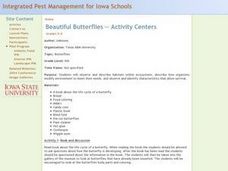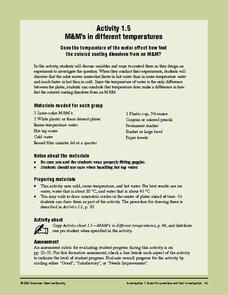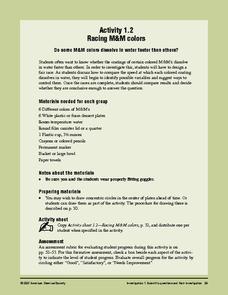Science Matters
Energy Flow
Budding scientists work collaboratively to reenact energy flow in a food chain. Scholars take on roles such as producer and consumer and perform tasks that symbolize energy flow in order to provide evidence of how much energy passes...
Curated OER
H2O in Us
Students discover through this activity that all organisms are composed of water. They find that 70 percent of their bodies are made up of water that is in thier cells and blood, and not free-flowing throughout their body.
Curated OER
Beautiful Butterflies - Activity Centers
Students describe habitats within ecosystems, describe how organisms modify environment to meet their needs, and identify characteristics for butterfly survival. For this butterfly lesson plan, students explore all aspects of the...
Curated OER
Combating Corrosion
Study corrosion on bronze statues with a hands-on lesson. As pupils place a penny in water with salt, they observe the changes in the penny throughout a period of a week. They then analyze the pre-conservation and the...
Curated OER
How would an oil spill affect a Marine Sanctuary?
Young scholars explore the concept of environmental stewardship. For this science lesson, students discover how scientists assess damages to the environment following oil spills. Young scholars conduct a simulation of a public meeting in...
Curated OER
Deep Ocean Currents
Students observe the interactions of different temperatures of water using colored ice and a thermometer and then compare the results with global ocean current solar heating. They identify where floating ice would be found in the ocean,...
Curated OER
Build a Thermometer
Students build a thermometer. For this weather lesson, students use red food coloring, rubber stoppers, and hard plastic tubing to build a thermometer. Students use their homemade thermometer to measure the temperature.
Curated OER
Winter Wonderland
Young scholars brainstorm a list of the activities they can participate in during the winter months. In groups, they rotate between stations in which they can practice or try the different winter sports. To end the lesson, they can play...
Curated OER
Words Hurt
Learners identify the various forms of bullying in a class discussion and to sort out the situations that can hurt outside and inside. They count the number of bullying incidents posted on the bulletin board to find which occur most...
Curated OER
Painting in Pink and Red
Students mix red and white to make different hues. In this color mixing instructional activity, students make a Valentine's Day project with a variety of shades of red and pink. They find the ratio of red and white and the color it...
American Chemical Society
M&M's in Different Temperatures
Help your class come up with a procedure for comparing the dissolving rates of colored candy coating in different temperatures of water. If you are placing importance on controlled variables with your class, make sure that they use equal...
Curated OER
Exploring Density with Salt and Fresh Water: Part 5
This particular lesson was written by the National Earth Science Teachers Association, but density is a concept that you can teach at the beginning of the school year in your life, physical, or earth science classes. It would be fun to...
American Chemical Society
Racing M&M Colors
More than anything, this is great practice in scientific inquiry. After discovering that the color coating of an M&M® dissolves in water during a preceding activity, investigators now question whether or not the color makes a...
DiscoverE
Nanosolutions
There are a billion reasons to use the resource! Well, not quite. A demonstration using food color and water shows scholars the meaning of nano. An iterative process results in diluting the concentration of food coloring by one tenth...
Curated OER
# 14 Experimenting with Copper (II) Solutions
Students determine that the relative concentration of copper ions in water can be determined by a color comparison. They make a copper (II) sulfate solution of a given concentration. Students dilute their initial solutions until their...
Curated OER
Observation Milk Fat Lesson
Turn your class loose to experiment with the different fat content in skim milk, whole milk, half and half, and heavy cream. This is a visually vibrant experiment, as learners drip food coloring on the surface of the products and measure...
Curated OER
Changing Planet: The Case of the Leaky Gyre
The fascinating video "Changing Planet: Fresh Water in the Arctic," introduces your oceanographers to the world's gyres. They learn that melting sea ice is making the gyres larger, and that the changes could, in turn, contribute even...
DiscoverE
Slime!!
Who's going to get slimed? Your entire class! Scholars create slime using Borax, water, and white glue. Some food coloring can give the slime a bit of color.
Curated OER
Passive Voice Exercises
What is the difference between the active voice and the passive voice? Focus on the latter with your middle schoolers to help them strengthen their writing. First, they identify which sentences are written in the passive. Then, they...
American Chemical Society
Investigating the Line
Note that this lesson is best paired with the preceding lesson in the unit. In that lesson, elementary physical scientists observed that the color coating of M&Ms® candies do not mix when dissolved off of the chocolate surface. Now...
Curated OER
Cup Capacity Tool: Measuring Cup
Students examine containers and their capacity. They fill a one-cup measuring cup with water and pour cups of water into other containers. Through observation, students discover how many cups make a pint, and how many teaspoons make a...
Curated OER
The Spread of Aids
This is an effective simulation of how communicable diseases such as AIDS can be spread throughout a population. Classmates exchange samples from their individual cups of liquid: one of them containing a dilute NaOH solution, and the...
Chicago Botanic Garden
Understanding the Greenhouse Effect
The greenhouse effect is important, for without it, life on Earth would not exist. An activity that includes modeling the greenhouse effect and acting out the Earth's energy balance makes up the first part in a series of seven...
Curated OER
What Is Viscosity?
Students experiment with the visocosity of corn syrup, mineral oil, vegetable oil, water, and honey. They research viscosity before beginning. Pupils draw the conclusion that the marble sinks more slowly in the liquids with greater...

























